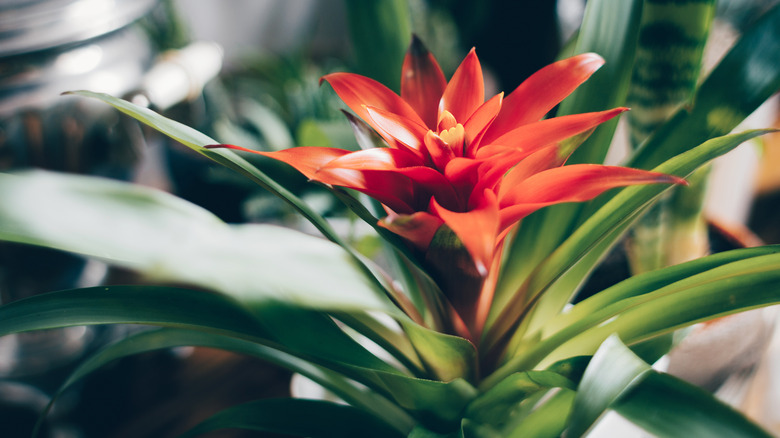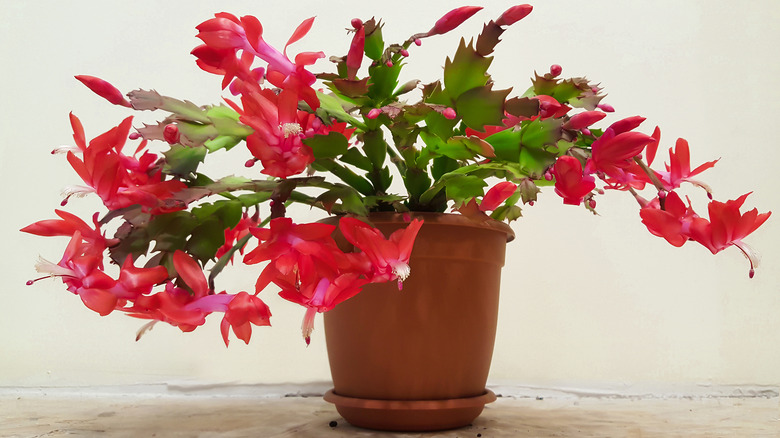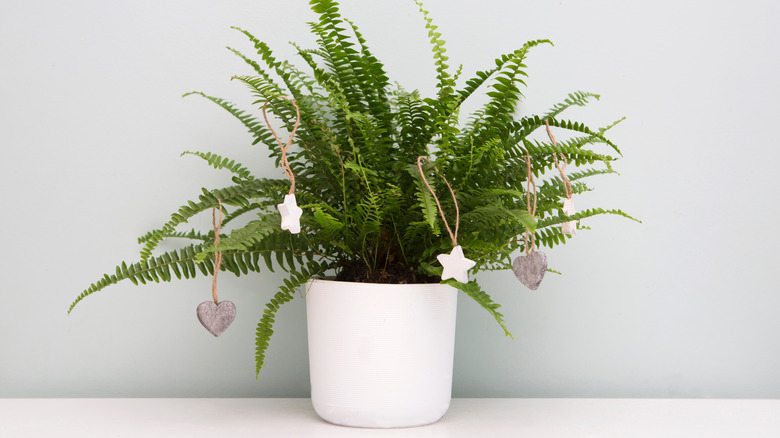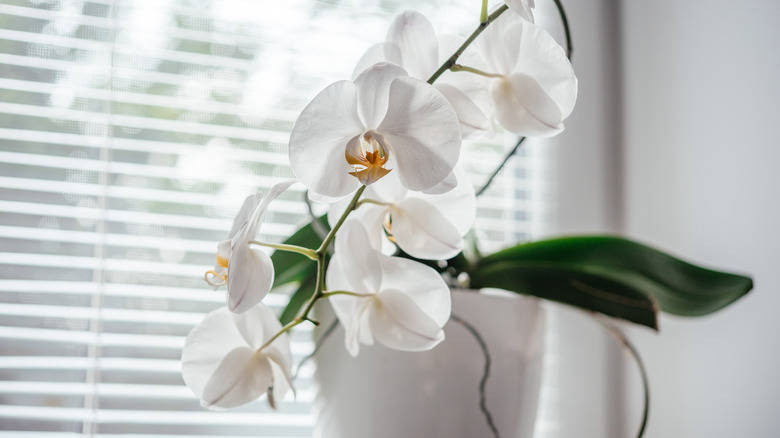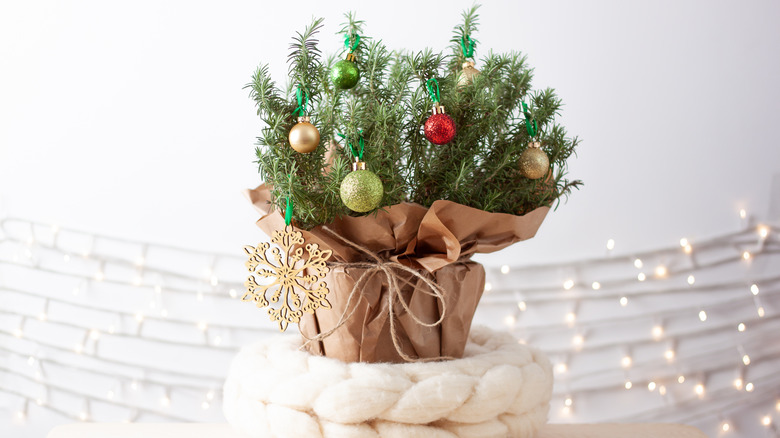5 Pet-Safe Plants For Your Holiday Decor
When the weather outside gets frightful, it is nice to bring a touch of the outdoors in with festive holiday houseplants. Before you bring in new greenery, ensure it is safe for your pets because you certainly do not want an emergency visit to the vet to ruin your holiday plans.
Some plants and traditional live decorations are extremely toxic to pets, while others are just harmful enough to cause discomfort. For example, different types of holly are commonly used as potted plants or hanging décor around the holidays. Wag states that while it is unlikely to cause significant issues, when a pet ingests any part of this plant, symptoms of toxicity range from nausea and vomiting to heart issues, depending on how much they ate. Mistletoe is another common holiday plant that is toxic to pets. Consumption by your furry friend can result in gastrointestinal problems, as well as heart problems. As you plan your holiday décor, it's best to enjoy faux versions of these toxic plants, but there are still plenty of beautiful live plants that you can enjoy safely in your home.
Bromeliad
Although poinsettias are not as toxic as once thought, the sap can cause mouth irritation if your pet takes a nibble, according to Montgomery Animal Hospital. To spare your dog or cat painful mouth sores, consider purchasing a bromeliad (Bromeliaceae) instead. This family of plants comes in many colors, but red is the natural choice to match traditional Christmas décor. And, when the season is over, you can continue to enjoy these beauties or gift them to a plant-loving friend.
Bromeliads love full sun, but if you only plan on keeping them for the season, you can place them anywhere indoors. Water your plants when the soil is dry one inch below the surface, and make sure they are in a container with good drainage. If you opt to place them in a decorative planter for the holidays, just make sure there is no standing water in the bottom of the pot since this will lead to root rot.
Christmas cactus
With its uniquely lobed leaves and bushy growth habit, the Christmas cactus (Schlumbergera) is a beautiful year-round houseplant, but it's the gorgeous red blooms that make it perfect for holiday decorating — and it's completely harmless to pets. This plant is so popular at this time of year you can often find it in full bloom at home improvement stores, department stores, or even your local grocery store. Although each bloom lasts a week or so, the plant can blossom continuously for up to six weeks, according to the Chicago Botanic Garden.
Keep your Christmas cactus blooming throughout the holiday season by watering regularly, but wait until the plant has finished flowering to fertilize monthly. To encourage blooms for the next holiday season, keep your plant in bright, indirect sunlight until early October states Lowe's. Then, move it to a dark room where it will get at least 12 hours of complete darkness a day. When you see buds emerge, move your plant back into a well-lighted area and enjoy its showy flowers.
Boston fern
The same beautiful fern you may use to adorn your summer porch can provide stunning indoor holiday décor that is safe for pets. The gorgeous texture offered by Boston ferns (Nephrolepis exaltata) provides the perfect foundation for a little extra pizzazz in your décor. Consider placing ferns in holiday-themed planters or even add lights and decorative items. Use LED Christmas lights tucked into the leaves to enjoy your holiday ferns day and night, but avoid incandescent bulbs because they can burn the leaves.
Since they are tropical plants, Boston ferns love humidity, so Gardener's Path recommends using a pebble tray to offer consistent moisture. You can also mist the leaves occasionally to help the plant absorb water through its leaves. Check the soil frequently and water when the surface is dry. Never let the roots sit in soggy soil. A Boston fern can thrive indoors with bright, indirect light where temperatures do not fall below 60 degrees Fahrenheit.
Phalaenopsis orchid
The long life and variety of colors available in Phalaenopsis orchid blooms make it a true show-stopper in your holiday décor. This gorgeous flower needs no additional ornamentation to use on your mantle or as your holiday centerpiece. Repot Me states the Phalaenopsis family of orchids typically blooms in the winter, and since orchids are non-toxic to pets, there's no concern if one of your four-legged family members does a small taste test.
Also known as the moth orchids, Phalaenopsis orchids require a moderate amount of care. They like bright, indirect light and only need to be watered about once a week. If you plan to keep your orchid after the blooms have faded, transplant it into a pot specifically made for orchids in a special orchid mix to give it the best chance of blooming again next year. Do not transplant an orchid while it is in bloom.
Rosemary
You may not think of rosemary as a houseplant, but during the holidays, you can often find rosemary (Salvia rosmarinus) bushes pruned into the shape of a Christmas tree or decorated for the holidays. This herb is safe for pets, according to Pet Keen, so if you decide to use it indoors as a mini-Christmas tree, you won't have to worry about your pets getting too close. Like many of the plants on this list, there are benefits beyond holiday beauty. Once the season has passed, you can move your rosemary bush into an outdoor planter or overwinter it in a garage, depending on how cold your winters get.
Rosemary is an exceptionally easy plant to grow, according to Get Busy Gardening. This herb prefers well-drained soil and can grow in partial shade or full sun. If you live in zone 7 or south, you can leave your rosemary outdoors year-round, but if you're further north, you'll need to bring it indoors during the coldest months.

